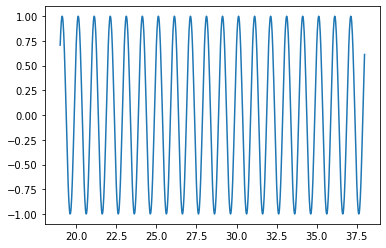Plotting every period and printing tables
Plotting every period and printing tables#
import numpy as np
import matplotlib.pyplot as plt
def start_stop_indices(t_pts, plot_start, plot_stop):
"""Return the indices in the array t_pts that are closed to the values
of plot_start and plot_stop. We use this for plots versus time
but it is clearly applies to any array of floats.
"""
start_index = (np.fabs(t_pts-plot_start)).argmin() # index in t_pts array
stop_index = (np.fabs(t_pts-plot_stop)).argmin() # index in t_pts array
return start_index, stop_index
omega_ext = 1.2
tau = 2.*np.pi / omega_ext
t_start = 0.
t_end = 100. * tau # 100 periods > what we need for any plot
delta_index = 50 # no. of steps per period
delta_t = tau / delta_index
t_pts = np.arange(t_start, t_end+delta_t, delta_t) # or use np.linspace
x_pts = np.sin(omega_ext * t_pts + np.pi/4.)
start, stop = start_stop_indices(t_pts, 19.*tau, 38.*tau)
fig = plt.figure()
ax = fig.add_subplot(1,1,1)
ax.plot(t_pts[start:stop]/tau, x_pts[start:stop])
[<matplotlib.lines.Line2D at 0x114fab6a0>]

for t, x in zip(t_pts[start:stop:delta_index] / tau,
x_pts[start:stop:delta_index]):
print(f' {t:.2f} {x: .5f}')
19.00 0.70711
20.00 0.70711
21.00 0.70711
22.00 0.70711
23.00 0.70711
24.00 0.70711
25.00 0.70711
26.00 0.70711
27.00 0.70711
28.00 0.70711
29.00 0.70711
30.00 0.70711
31.00 0.70711
32.00 0.70711
33.00 0.70711
34.00 0.70711
35.00 0.70711
36.00 0.70711
37.00 0.70711
